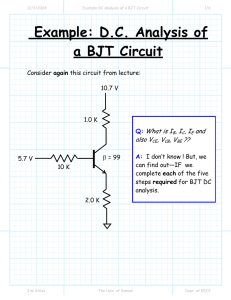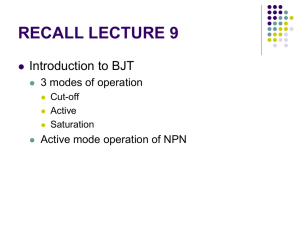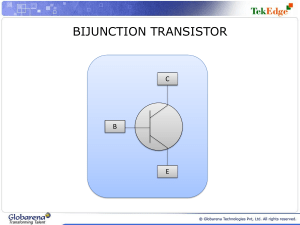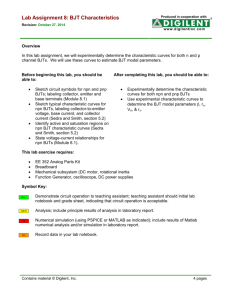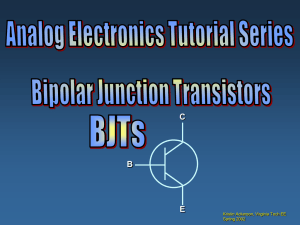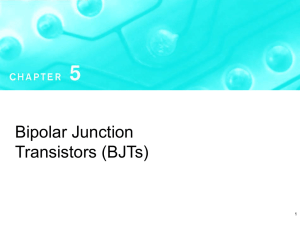klik disini - wahyuningsih TEI
advertisement
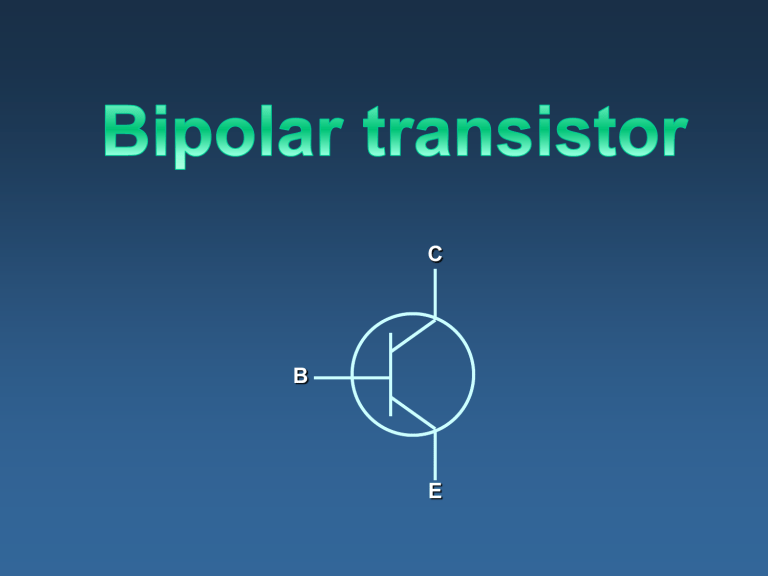
C B E BJT – Bipolar Junction Transistor Dua Type BJT Transistor: npn E n pnp p n Cross Section C C E p n p Cross Section B C B B B Symbol Symbol E • • • C Collector doping is usually ~ 106 Base doping is slightly higher ~ 107 – 108 Emitter doping is much higher ~ 1015 E Rumusan Dasar BJT IE - E IC VCE + IE C - - VBE VBC IB + + E + VEC + VEB IC - C + VCB IB - - B B npn pnp IE = IB + IC IE = IB + IC VCE = -VBC + VBE VEC = VEB - VCB DC and DC = Arus penguatan Common-emitter = Arus penguatan Common-base = IC = IC IB IE Hubungan antara dua parameters tersebut adalah: = +1 = 1- BJT Example Konfigurasi Common-Base Transistor NPN C Diketahui : IB = 50 A , IC = 1 mA Hitung VCB IC + _ IE , , and Penyelesaian: IE = IB + IC = 0.05 mA + 1 mA = 1.05 mA IB B : = IC / IB = 1 mA / 0.05 mA = 20 VBE + _ IE E = IC / IE = 1 mA / 1.05 mA = 0.95238 Juga dapat dicari dengan dengan rumus sebagai berikut. = = 20 = 0.95238 +1 21 Curve Transconductance BJT Transistor Tipe NPN Arus Collector : IC = IES eVBE/VT IC Transconductance: (slope of the curve) 8 mA gm = IC / VBE 6 mA IES = Arus saturasi terbalik dari B-E Junction. 4 mA VT = kT/q = 26 mV (@ T=300K) = Coefisien emisi 2 mA biasanya ~1 0.7 V VBE Modes of Operation Active: • Posisi terbaik pada daerah operasi • Beroperasi sebagai penguat Saturation: • Transistor berada sebagaimana pada posisi short circuit. Cutoff: • Arus transistor nol • Transistor yang edial sebagaimana posisi saklar terbuka * Note: There is also a mode of operation called inverse active, but it is rarely used. TigaTypes dari Bias BJT Bias transistor adalah kondisi tegangan dimana transistor tersebut bisa melakukan operasi (kerja). Bias Common-Base (CB) : input = VEB & IE output = VCB & IC Bias Common-Emitter (CE): input = VBE & IB output = VCE & IC Bias Common-Collector (CC): input = VBC & IB output = VEC & IE Common-Base Although the Common-Base configuration is not the most common biasing type, it is often helpful in the understanding of how the BJT works. Emitter-Current Curves Saturation Region IC Active Region IE Cutoff IE = 0 VCB Common-Base Circuit Diagram: NPN Transistor C VCE IC VCB The Table Below lists assumptions that can be made for the attributes of the common-base biased circuit in the different regions of operation. Given for a Silicon NPN transistor. Region of Operation IC Active IB Saturation Max Cutoff ~0 VCE E VBE + _ + _ IB B VCB VBE =VBE+VCE ~0.7V ~0V IE VBE VCB 0V C-B Bias E-B Bias Rev. Fwd. ~0.7V -0.7V<VCE<0 Fwd. Fwd. =VBE+VCE 0V 0V Rev. None /Rev. Common-Emitter Circuit Diagram VCE IC + _ Collector-Current Curves IC VCC IB Active Region IB Region of Description Operation Active Arus basis yang kecil mengontrol arus colektor yang besar Saturation VCE(sat) ~ 0.2V, VCE increases with IC Cutoff Pada kondisi IB mendekati 0, edialnya, IC juga sama dengan 0. VCE Saturation Region Cutoff Region IB = 0 Common-Collector Emitter-Current Curves The CommonCollector biasing circuit is basically equivalent to the common-emitter biased circuit except instead of looking at IC as a function of VCE and IB we are looking at IE. Also, since ~ 1, and = IC/IE that means IC~IE IE Active Region IB VCE Saturation Region Cutoff Region IB = 0 Eber-Moll BJT Model The Eber-Moll Model for BJTs is fairly complex, but it is valid in all regions of BJT operation. The circuit diagram below shows all the components of the Eber-Moll Model: E IE IC RIC RIE IF IR IB B C Eber-Moll BJT Model R = Common-base current gain (in forward active mode) F = Common-base current gain (in inverse active mode) IES = Reverse-Saturation Current of B-E Junction ICS = Reverse-Saturation Current of B-C Junction IC = FIF – IR IB = IE - IC IE = IF - RIR IF = IES [exp(qVBE/kT) – 1] IR = IC [exp(qVBC/kT) – 1] If IES & ICS are not given, they can be determined using various BJT parameters. Small Signal BJT Equivalent Circuit The small-signal model can be used when the BJT is in the active region. The small-signal active-region model for a CB circuit is shown below: iB iC B iB r r = ( + 1) * VT IE @ = 1 and T = 25C r = ( + 1) * 0.026 IE iE E Recall: = IC / IB C The Early Effect (Early Voltage) IC Note: Common-Emitter Configuration IB -VA VCE Green = Ideal IC Orange = Actual IC (IC’) IC’ = IC VCE + 1 VA Early Effect Example Given: The common-emitter circuit below with IB = 25A, VCC = 15V, = 100 and VA = 80. Find: a) The ideal collector current b) The actual collector current Circuit Diagram IC VCE = 100 = IC/IB a) VCC + _ IC = 100 * IB = 100 * (25x10-6 A) IB IC = 2.5 mA b) IC’ = IC VCE + 1 VA IC’ = 2.96 mA = 2.5x10-3 15 + 1 80 = 2.96 mA Breakdown Voltage The maximum voltage that the BJT can withstand. BVCEO = The breakdown voltage for a common-emitter biased circuit. This breakdown voltage usually ranges from ~20-1000 Volts. BVCBO = The breakdown voltage for a common-base biased circuit. This breakdown voltage is usually much higher than BVCEO and has a minimum value of ~60 Volts. Breakdown Voltage is Determined By: • • The Base Width Material Being Used • Doping Levels • Biasing Voltage Sources Dailey, Denton. Electronic Devices and Circuits, Discrete and Integrated. Prentice Hall, New Jersey: 2001. (pp 84-153) 1 Figure 3.7, Transconductance curve for a typical npn transistor, pg 90. Liou, J.J. and Yuan, J.S. Semiconductor Device Physics and Simulation. Plenum Press, New York: 1998. Neamen, Donald. Semiconductor Physics & Devices. Basic Principles. McGraw-Hill, Boston: 1997. (pp 351-409) Web Sites http://www.infoplease.com/ce6/sci/A0861609.html
